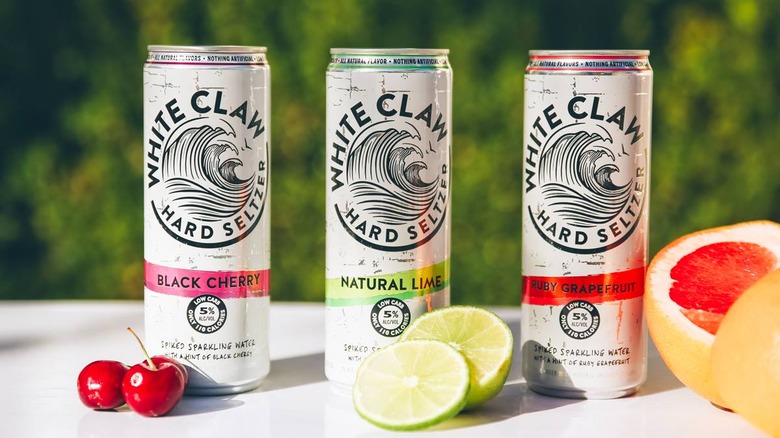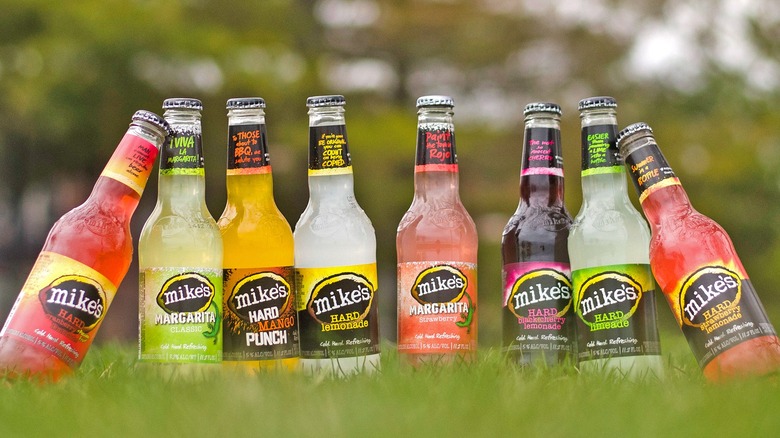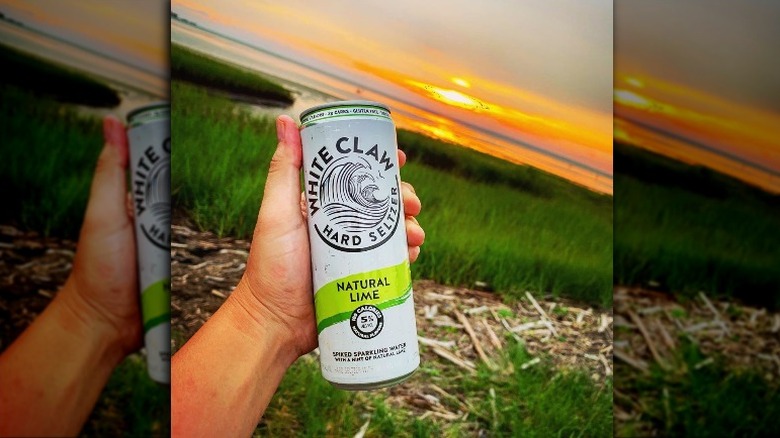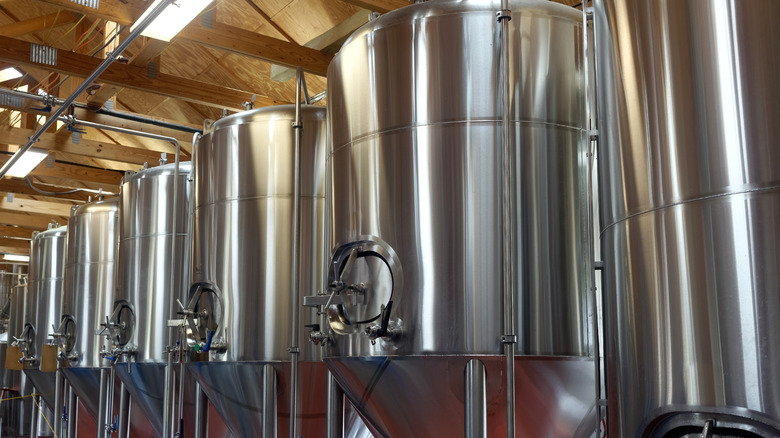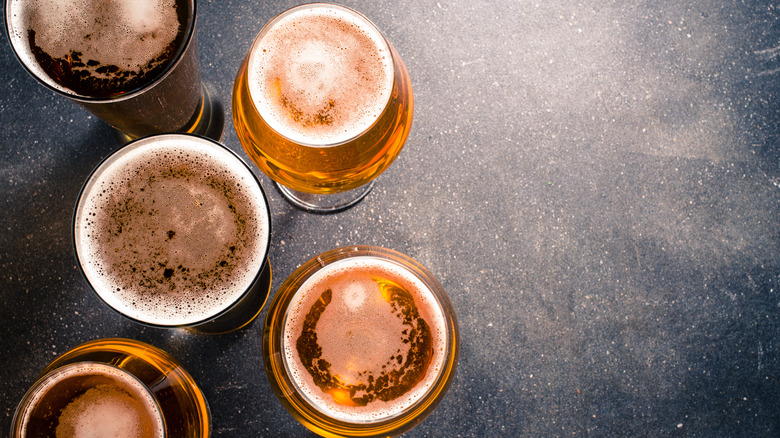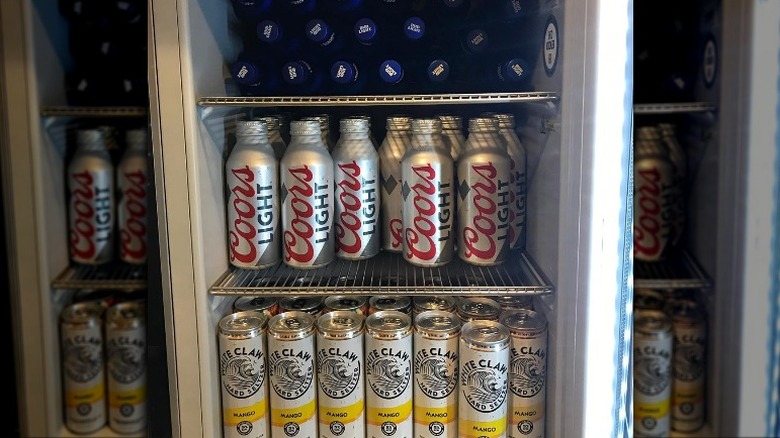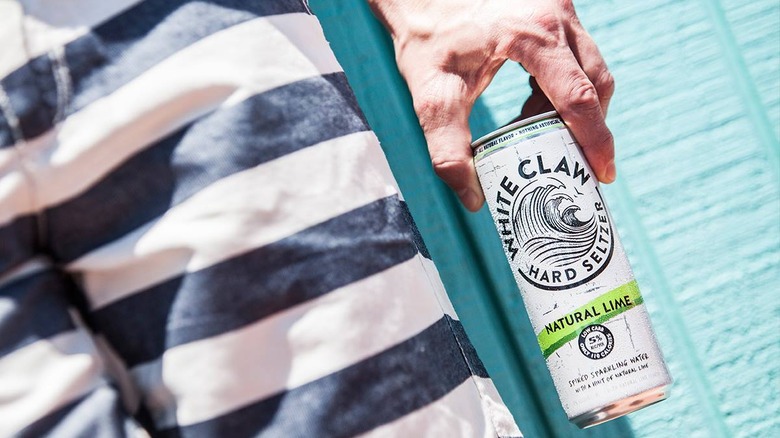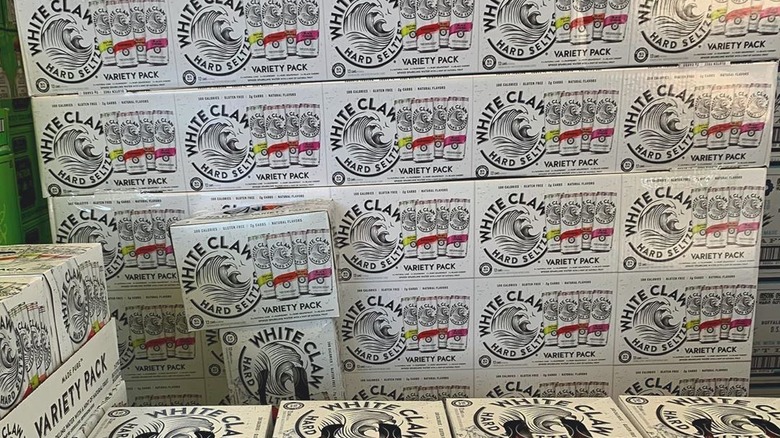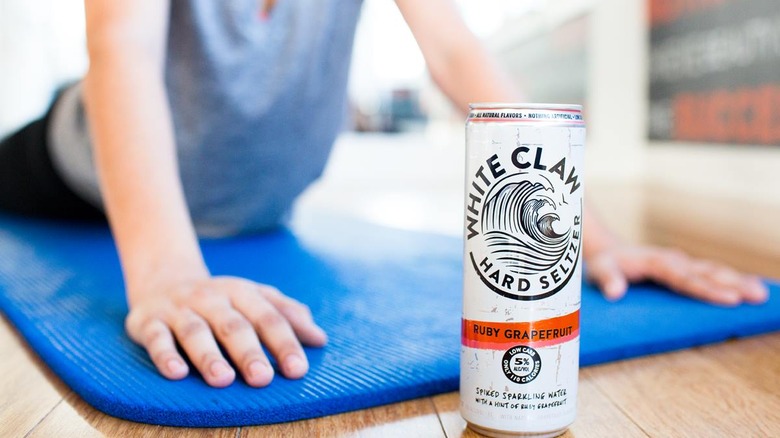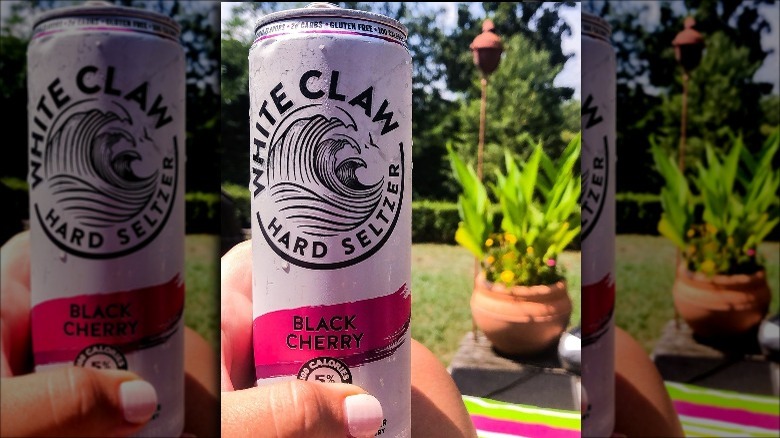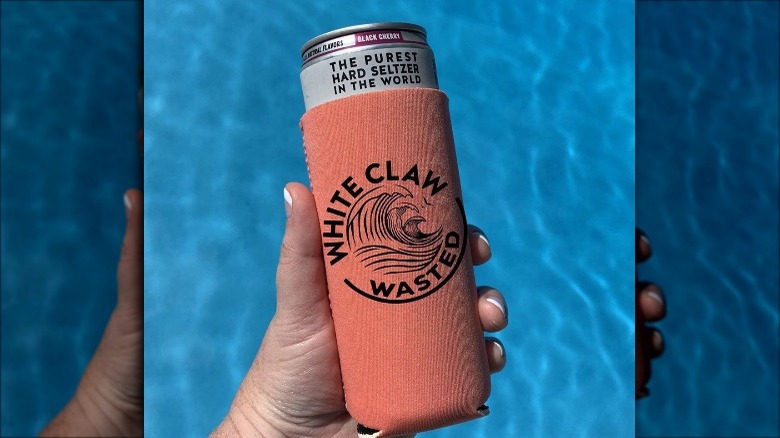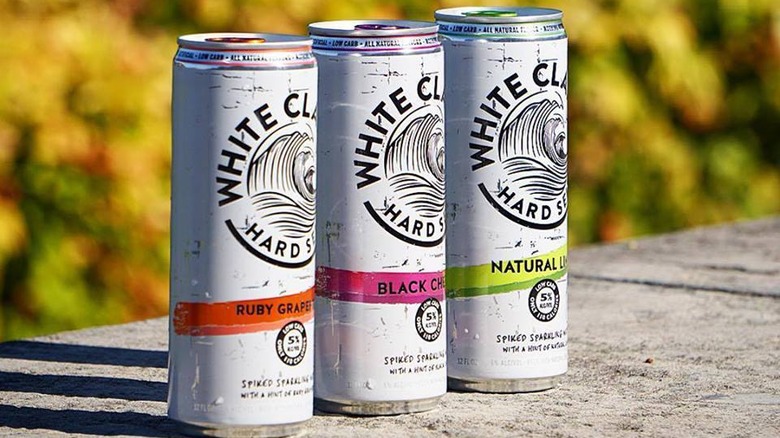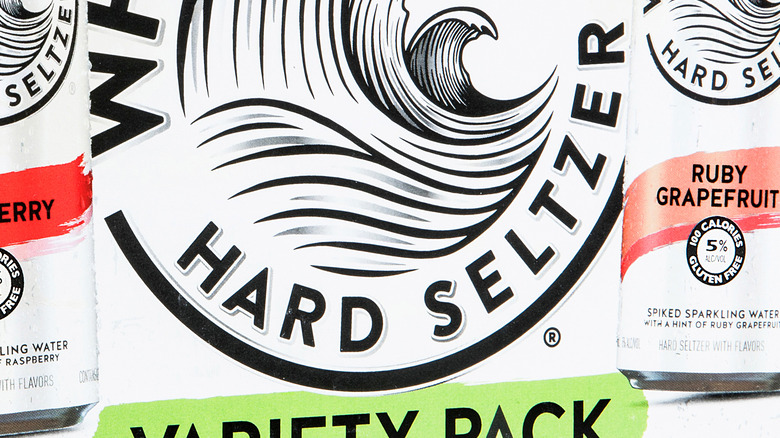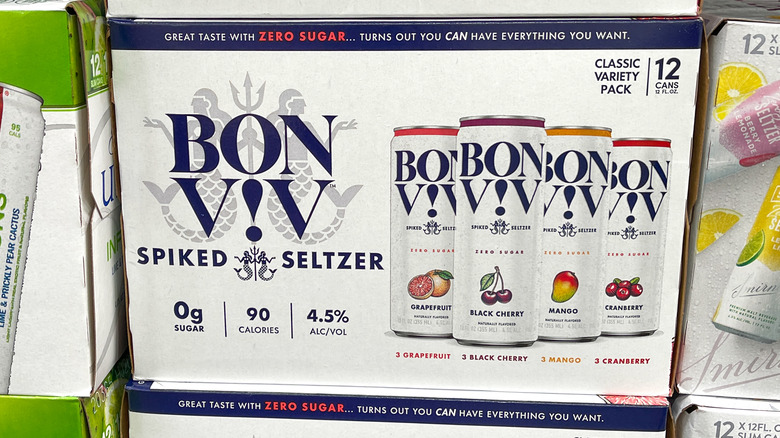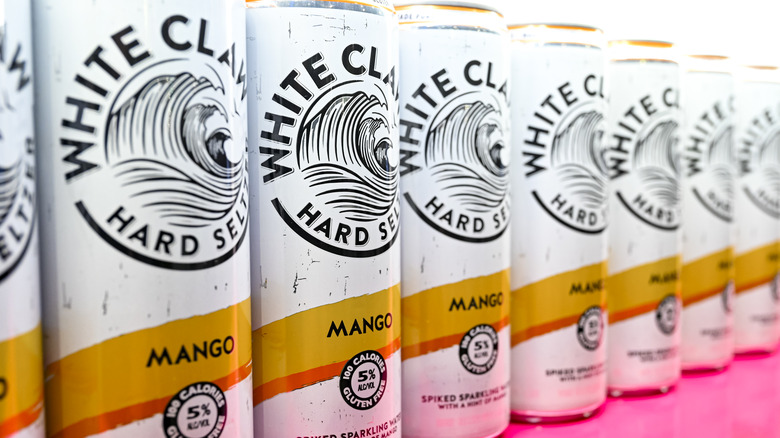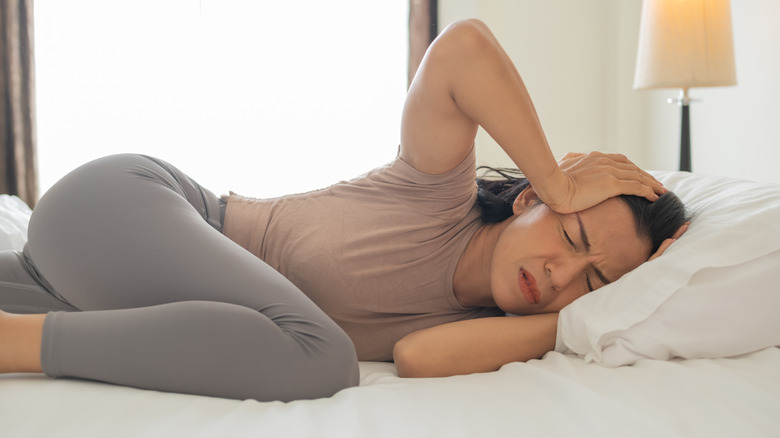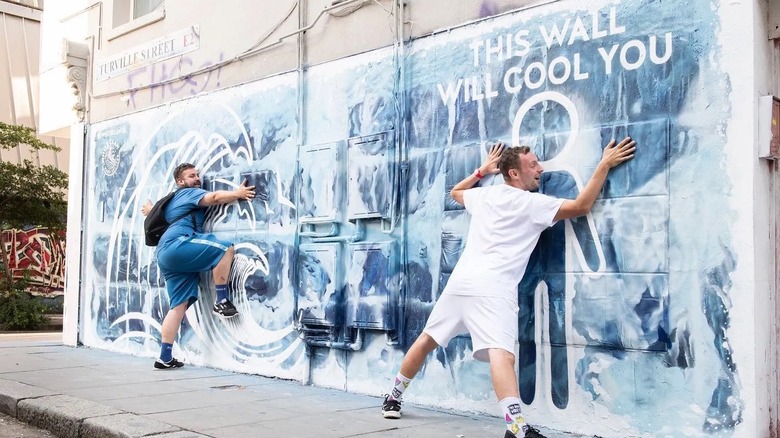The Untold Truth Of White Claw Hard Seltzer
If you've taken a stroll down the beer aisle at your local grocery store lately, chances are you've seen the mass amount of cases of hard seltzer on the shelves. At this point, there's a number of different choices among your tried and true beer and wine cooler options, but there may be one brand standing out for people just a bit more than the others. White Claw Hard Seltzer has taken the world by storm, with its slim, white can and bright, colorful graphics. But what exactly is this stuff?
White Claw is in a similar family to sparkling waters, but with the addition of alcohol, of course. And people can't seem to get enough of this ideal summer sipper. But why? We decided to take a deep dive into the brand, looking at how White Claw is made, the controversies surrounding it, and all the ways (and reasons) it's trending on Instagram. This is the untold truth of White Claw Hard Seltzer.
White Claw is the cousin of Mike's Hard Lemonade
White Claw debuted on the market in 2016, right around the same time flavored, carbonated waters were taking over the beverage aisle. There was a huge surge of interest in zero-calorie sparkling water, and the makers of White Claw decided to jump on board. But White Claw wasn't necessarily a new company that just fell from the sky.
White Claw is owned by Mark Anthony Brands, the same company that owns Mike's Hard Lemonade, which debuted in 1999. The Mark Anthony Company, founded in 1972, has a diverse number of private beverage companies in their portfolio including wine, beer and ready-to-drink products.
The company was the pioneer of the flavored malt category by launching Mike's Hard, so it's no wonder they were one of the first to take the world by storm by introducing White Claw with its four original flavors (as of August 2019, there are six flavors).
Technically, White Claw is a malt beverage
There's a lot of hype surrounding White Claw, especially as some regard the sparkling beverage as a "vodka soda in a can." And while it may resemble your favorite refreshing cocktail from the bar, according to Vine Pair, it's definitely not a vodka soda or the newest IPA on the market. But what exactly is it?
According to Vine Pair, this bubbly sensation is a flavored malt beverage. A White Claw rep told Vine Pair it's "a blend of seltzer water, its gluten-free alcohol base, and a hint of fruit flavor." And it's in the same line of beverages as its cousin, Mike's Hard Lemonade, as well as other portable drinks like Smirnoff Ice and wine coolers.
But according to Eater, White Claw just might be more of an upscale version than your everyday malt beverage. "It's an upscale, aspirational brand, one that doesn't carry the same trashy, low-budget connotations as other malt liquor beverages like wine coolers," they said. But whatever level of the pedestal you decide to place White Claw on, it's still made through a similar process as other malt beverages.
White Claw goes through a fermentation process
In some ways, White Claw can be compared to beer because it goes through a similar fermentation process, but it's not quite the same exact method. When brewing beer, a brewer utilizes malt, water, and yeast and typically adds hops for flavoring. During the brewing process, the malt feeds the yeast, giving it nutrients throughout the fermentation stage and ultimately producing the carbon dioxide to create alcohol.
According to Town & Country, White Claw still goes through fermentation, but the procedure is very specific. "The brand uses a proprietary brewing process that uses fermented sugar and a yeast strain that took a year to develop," they said. By utilizing a very similar process as brewing beer, they are able to ferment sugar using their specialized yeast to break it down. Once fermentation of the sugar occurs, and alcohol develops, the carbonation can be added to finish off that refreshing can of White Claw.
White Claw has just about the same amount of alcohol as a beer
Part of the allure of White Claw is the ability to consume alcohol in an easily-drinkable can. Some might even say it's totally smashable. The same allure has existed for beer for years, partially due to the portability of the product, but White Claw is closely matching it now.
According to the Public Health Institute, a light beer's alcohol content has historically been 4.2 percent alcohol by volume (ABV). For standard beer, you'll typically see five percent, while a craft beer or stronger beer styles such as a porter or stout can range from six percent to 12 percent. But it's not often you're chugging a stout at the beach or on a boat on the lake. They're just not that refreshing. And that's where the beauty of White Claw comes in for most consumers.
With five percent ABV in a 12-ounce can, White Claw can pack just as much of a punch as most standard beers. According to The Spruce Eats, ABV labels explain exactly how much actual alcohol can be found in a beverage. For White Claw, that means its 12-ounce can, at five percent ABV, has .6 ounces of pure alcohol. That's less than your average shot glass, but can add up quickly once you sip more than one — and that happens pretty easily when you're sipping something fruity and refreshing.
White Claw is becoming more popular than beer
Beer has gained increasing popularity in recent years, especially in the craft beer market. But what happens when hard seltzer replaces that?
Sandy Vox, Assistant Sales Manager for the beer category at the Jewel-Osco supermarket chain, told the Chicago Tribune that shelf space in her stores is being transferred from domestic beer options to more room for hard seltzer. In addition, less shelf space is being devoted to craft brews as well to make room for the spike in popularity. According to Vox, White Claw has a truly broad appeal. "At Jewel-Osco, hard seltzer has likely poached a lot of sales that once went to sweet beers. Light beer is also suffering," Vox said "The new drinker whose first beer was Miller Lite or Bud Light are grabbing seltzers."
According to Sanjiv Gajiwala, Senior Vice President of Marketing for Mark Anthony Group, much of the consumption of White Claw is coming from consumers who previously enjoyed beverages in the beer sector. Split into styles, 25 percent of sales are coming from light beer drinkers, 11 percent from domestic premium drinkers (such as Budweiser), nine percent from craft beer drinkers, and eight percent from imported beer drinkers.
White Claw is just as popular with men as women
While there are plenty of stereotypes surrounding women ordering lighter cocktails like vodka sodas at the bar, that stereotype isn't necessarily translating to the White Claw overtaking. At this point, it's possible White Claw is on an equal playing field for the level of consumption among both men and women.
Sandy Vox, Assistant Sales Manager for the beer category at the Jewel-Osco supermarket chain, told the Chicago Tribune that it's surprising how many men are embracing the seltzer category. "I thought it would be more women driven, but it's 50-50," she said.
According to Business Insider, there are plenty of male groups packing the beverage on the go. White Claw fan, Ben Shea, told Business Insider he hadn't heard of White claw when he first tried it, but now he's hooked. "Shea and his crew are not alone," said Bethany Biron for Business Insider. "At barbecues, on beaches, and at fraternity parties, legions of men are suddenly singing the praises of hard seltzer."
White Claw is leading the hard seltzer market
Since its debut, White Claw has continued to increase in sales, slowly taking over the beverage aisle. Overall, ready-to-go alcoholic beverage sales have skyrocketed, and sales in the malt-based cocktail category have increased by 574 percent.
With such a spike in the market, a number of companies have introduced a malt-based cocktail beverage similar to White Claw including brands like Truly, Pure and Bon & Viv. And with an expected growth of the category from its current worth at $550 million to $2.5 billion by 2021, jumping from a consumption rate of 14 million cases in 2018 to 72 million cases in 2021, it's no wonder there are as many companies getting on board as possible.
But even with the addition of portable malt beverages from large companies all the way down to craft breweries, White Claw is still leading the charge. According to Business Insider, White Claw is leading the market with 50 percent of the hard seltzer share, but plenty of other beverage companies are hoping to catch up. So far, White Claw doesn't have to put too much worry into the competition.
White Claw may be healthier than beer
A huge part of why White Claw is so loved is its calorie count. With only 100 calories per can and two carbohydrates, it's no wonder this has become such a popular summer sipper. Calorie counts for beer range depending on the style and brewery, but they can generally be found between 96 calories in a light beer all the way to over 300 calories in something on the darker end of the spectrum. An average woman should consume 2,000 calories daily, while a man should consume 2,500 according to Healthline, and those counts can add up fast, especially while drinking.
According to the Chicago Tribune, part of White Claw's allure is definitely based on the issue of health and wellness. Low-carb, low-calorie beers have had much success introducing new products on the market, so it's only natural the malt beverage industry would follow suit. "Hard seltzers fit seamlessly with the trend," they said. "They're generally low in calories, sugar and carbohydrates and often gluten-free."
White Claw is gluten-free
For those with Celiac disease or gluten sensitivity, or for those who just prefer to avoid gluten because they feel better without it, White Claw has been an ideal option. According to Healthline, gluten is a protein, which is typically found in grains such as rye or barley. Because barley is used in the process of brewing beer, most beers are typically not gluten-free. In addition, many malt beverages and wine coolers utilize barley in their brewing process as well, causing many options to be off the list for those looking for a fruity, portable beverage without all the gluten. Some wines or dessert wines also incorporate grain in their production process.
White Claw boasts that they're a gluten-free option, naturally made with gluten-free ingredients, allowing a larger market to enjoy their sparkling beverages. Other brands in the hard seltzer realm such as Truly are gluten-free as well, but others such as Henry's Hard Sparkling Cider or Nauti Seltzer can't make the same gluten-free claim.
White Claw is taking the internet by storm
It's hard to believe a malt beverage could become so popular so fast, but a lot of that has to do with its popularity across the internet.
Since White Claw's debut just a few years ago, there has been a number of fan Instagram accounts popping up such as @itsawhiteclawsummer. The #whiteclaw hashtag has grown to include over 61,000 posts and counting, showcasing photos of people showing off how much they enjoy the bubbly beverage.
According to Sanjiv Gajiwala, Senior Vice President of Marketing for Mark Anthony Group, the intentional packaging plays a role in that popularity as well. Gajiwala told the Chicago Tribune, the sleek and slender can all adds to the experience. "Part of the experience is the can and the package," Gajiwala said. "People like the sleek can and what it says about them and the premium experience." With such an intentional design, it's no wonder so many people are snapping and Instagramming everywhere they take White Claw with them.
A cult slogan surrounding White Claw Hard Seltzer was served a cease and desist order
With the exponential growth of White Claw in just a few years, it was only a matter of time before a video surrounding the bubbly beverage went viral. Comedian Trevor Wallace posted his "*Drinks White Claw Once*" video on his Youtube Channel in June, 2019, and it became an instant hit. The video, which pokes fun at people drinking White Claw and those fans who are immediately obsessed with it after one sip, has garnered over 2 million views and counting.
In the video, Wallace uses the phrase "ain't no laws when you're drinking claws," and the slogan immediately went viral. Following the video, Wallace released T-shirts with the same slogan, but according to Vine Pair, he was asked to stop selling them.
A White Claw spokesperson told Vine Pair that the comedian was issued a cease and desist order, stating, "Trevor was asked by White Claw's legal team to not sell these shirts." The shirts have since been taken down, but Wallace's video views continue to climb.
There's a White Claw Coin Game
As if the hype surrounding White Claw isn't enough, there are now bars implementing White Claw games in their buildings. Similar to the coin-operated claw machines that may earn you a teddy bear or a claw full of candy, this White Claw game at El Hefe in Scottsdale, Arizona is becoming incredibly popular. According to AZ Central, the bar ran out of White Claws multiple times when they first introduced the game to their customers, as they all lined up to play.
The game allows guests to try and catch a White Claw can with the claw machine. If you do, you win a coupon for a discount on a White Claw at the bar. The machine can't offer self-serve drinks, so the cans are empty for the game, but the prize is just as rewarding.
Because of the craze surrounding the game, which the bar worked to develop with White Claw reps, they're planning to add another machine to their other location in Tempe, Arizona. With the popularity surrounding a coin-play game, it makes you wonder what might be next for this booming sensation.
White Claw helped popularize the term hard seltzer
The term "hard seltzer" is ubiquitous nowadays but that wasn't always the case, and we can likely thank White Claw for the change.
According to VinePair, prior to 2019, "hard seltzer" and "spiked seltzer" were used evenly. It simply depended on which region of the country you were in. Google trends data showed most people in the Western United States used the phrase "hard seltzer" in their internet searches, while those along the East Coast and parts of the Midwest preferred "spiked seltzer." Fast forward to the summer of 2019 and the vast majority of the U.S. had added "hard seltzer" to their lexicon, the term of choice for White Claw Hard Seltzer.
There's no proof that White Claw alone is responsible for the change, but you don't need to be much of a detective to connect the dots. The naming shift and White Claw's popularity surge occurred simultaneously. In the 12-month span from May 2018 to May 2019, sales of the drink grew an eye-popping 320%.
By the end, only seven states were still searching for "spiked seltzer," and they were all located in the Northeast. VinePair surmises that people in this region may have been influenced by another seltzer brand, Truly, which is a subsidiary of the local Boston Beer Company. When the brand was established in 2016, it marketed itself as "Truly Spiked and Sparkling." It has since joined the party and rebranded as Truly Hard Seltzer.
White Claw was not the first hard seltzer to hit the market
White Claw may be the most popular hard seltzer on the market, but it cannot claim the title of being the first hard seltzer on the market. According to VinePair, that distinction belongs to Bon & Viv Spiked Seltzer, which debuted in 2013, three years before White Claw ever hit the shelf (via Brewbound).
So how did this Bon & Viv drink come about? As the story goes, an aspiring beverage entrepreneur named Nick Shields found himself at a Westport, Connecticut bar in 2012 when he overheard a group of women order vodka sodas. Shields believed he could recreate the popular drink in a canned form. Working at Boston's Haffenreffer Brewery at the time, he began experimenting with his new concoction. One year and 100 batches later, he finally perfected the recipe. Originally called SpikedSeltzer, the brand launched in 2013. Three years later, it caught the eye of brewing powerhouse Anheuser-Busch, which purchased the company for an undisclosed sum. SpikedSeltzer was later rebranded as Bon & Viv Spiked Seltzer, which is what you'll see on the shelves today.
So, before you go singing the praises of White Claw, remember it was Bon & Viv that deserves the credit for creating a drink category that is currently worth nearly $13.5 billion (via Grand View Research).
There was a White Claw shortage
White Claw has experienced a meteoric rise over the past several years. In fact, the drink became so popular at one point that the company couldn't keep up with demand. In September 2019, cases were flying off the shelves faster than they could be restocked, resulting in a nationwide shortage of White Claw (via Business Insider).
The skyrocketing demand for the hard seltzer caused supply chain woes, White Claw president Phil Rosse told CBS. In response, the company began to allocate its product, limiting the amount each distributor received and leaving fewer cases on the shelf. "We are working around the clock to increase supply given the rapid growth in consumer demand," Sanjiv Gajiwala, the senior vice president of marketing at White Claw, told Business Insider. Gajiwala explained that the brand was working to get its drinks to distributing partners in each market in order to "... get back to our normal safety stock position."
Retailers were forced to make do with whatever they could get, and thirsty consumers had to become early birds. "It doesn't matter how much White Claw we get in — just about any amount of the cases we bring in will be gone in the next couple days," one liquor store manager said at the time. "The people buying it are getting in early and getting a lot, knowing it will sell out."
A White Claw hangover may differ from a wine or beer hangover
Like any good thing, too much White Claw can be a not-so-good thing. So while the hard seltzer may taste better than other alcohols, it too can cause a hangover. However, according to Bustle, a White Claw hangover may be more or less intense than one derived from beer or wine.
On the downside, White Claw's high sugar content can lead to a stomachache the next day. "As far as stomachaches, these can be caused by sweetened seltzers that often get their taste from sugar alcohols, which your gastrointestinal tract might have a tough time breaking down," Dr. Niket Sonpal told Bustle. Speaking of flavor, because white Claw tastes so good, people tend to drink more or it. This puts more alcohol into the body, increasing the likelihood of a hangover.
The hard seltzer does have some qualities, however, that may make for a less-severe hangover compared to other alcohols. For starters, it has a lower ABV than wine. If you drink as much White Claw as you would wine, you'll have ingested less alcohol. While hard seltzer has a similar ABV as beer, it is gluten-free, making it a better option for those with a gluten intolerance. Furthermore, White Claw doesn't contain congeners, chemical byproducts of fermentation believed to contribute to hangovers. Alcohols such as red wine and whiskey contain high levels of congeners, which can lead to a rough morning after.
There are many different White Claw products
It would have been easy for White Claw to ride the wave of success its trademark variety packs have provided. Instead, the company has continued to evolve with the introduction of several new products.
It started in March 2021 when White Claw unveiled hard seltzer iced tea (via PR Newswire). Available in four flavors (Lemon, Raspberry, Mango, and Peach), each drink contains the same 100 calories and 5% ABV White Claw is known for. "You combine the leader in hard seltzer with the ever-growing tea trend, and you've got a winner," said John Shea, the company's chief marketing officer. The very next month, White Claw dialed things up with its new Surge line (via PR Newswire). Unlike their smaller, less-boozy sister products, Surge comes in 16-ounce cans and contains 8% alcohol. "We know some consumers are looking for a higher alcohol option from White Claw, and that's what White Claw Hard Seltzer Surge delivers," Shea said.
In early 2022, the company debuted White Claw Surf. According to a press release, the new line is the brand's first "full flavor offering." Those "full flavors" include Citrus Yuzu Smash, Tropical Pomelo Smash, Watermelon Lime Smash, and Wildberry Acai Smash. Most recently, White Claw unveiled REFRSHR, a new take on hard lemonade (via PR Newswire). REFRSHR comes in four distinctly unique flavor combinations: Limón with Calamansi, Blood Orange with Black Raspberry, Blackberry with Red Cherry, and Strawberry with Kiwi.
White Claw helped cool down Londoners during a record heat wave
As we all unfortunately know by now, heat waves are a common occurrence everywhere these days — including across the pond. In mid-July 2022, the United Kingdom experienced a record-breaking heat wave. According to the Washington Post, the temperature on July 19 reached 104.5 degrees Fahrenheit, 2.9 degrees higher than any temperature ever recorded in Britain.
That very same day, White Claw came to the rescue with a particularly unique marketing ploy. The hard seltzer brand installed a temporary mural in the Shoreditch neighborhood of London (via the Spirit Business). This wasn't just any mural, of course. Depicting ice and cool-blue waves, the installation was made out of heat-proof paint and contained built-in cooling pads that absorb body heat. Passersby were invited to touch, lean against, and even hug the painting for a moment of cooling relief. "With record breaking temperatures, we wanted to give Londoners a much-needed moment of light refreshment on this scorching day," Michael Dean, White Claw U.K.'s head of marketing, said. "What better way to cool them down than with a White Claw in hand and a billboard that will absorb all heat."
The mural helped cool off the London public for two weeks before being taken down.
